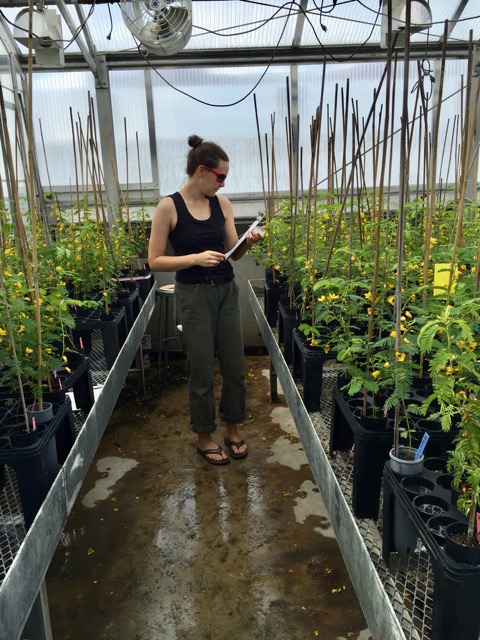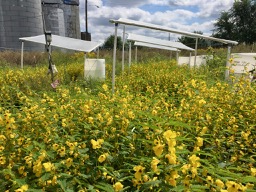
Peschel Wins SER-MWGL Student Research Award for 2017
Anna Peschel, a PhD student at the University of Minnesota, Twin Cities Campus, won the award for her research which tackles the persistent and challenging question of local adaptation. Peschel said in her research award proposal that she is interested specifically in the critical question of whether “adaptive evolution can proceed at a sufficiently rapid pace to maintain population fitness and demographic stability.” The question of species persistence in the age of climate change is especially relevant, Peschel emphasizes.

Anna Peschel at work in her greenhouse with the subject of her research, Chamaecrista fasciculata (Partridge pea). Plants will be hand pollinated to produce seed that she will sow into the field this fall.
Peschel’s will be awarded $1000 by the Midwest Great Lakes Chapter of the Society for Ecological Restoration to help support her research. This is the third year that a student research award has been offered to student members for work done in the seven-state chapter area. Previous winners include Becky Barak in 2016 and Amy Alstad in 2015.

Peschel at the McCarthy Lake WMA in Minnesota, one of her field sites.
Peschel’s work is focused on the tall grass prairie region of Minnesota that once covered 18 million acres, but now less than two percent remains. Peschel says in her research proposal, “Tallgrass prairie plants are at risk of extinction from climate change unless adaptation by natural selection restores the growth rates of their populations to levels that maintain them.”
Peschel’s research will use the annual prairie legume, partridge pea as a focal organism to represent tall grass prairie plants and her research will attempt to determine its “adaptive capacity along an aridity gradient mimicking environmental conditions predicted to reach eastern Minnesota in 25-30 years.”

Precipitation exclusion structures Peschel will employ to mimic drought.
The results of Peschel’s research will be presented at SER MWGL’s annual meeting next April in Steven’s Point, Wisconsin.

